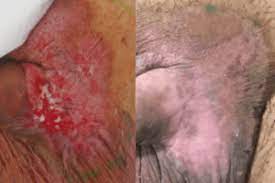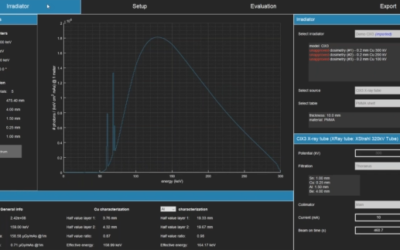
(Left) Maximum toxicity of dry desquamation in normal skin surrounding tumorlysis of the EMPD. (Right) Complete response and complete skin healing four weeks after RT.
In the published study, “Split Course Superficial Radiotherapy in Scrotal Extramammary Paget’s Disease Allows Course Completion With Minimal Side Effects: A Case Study” by Gerald B. Fogarty, et al., the Xstrahl 300 system was used to treat Paget’s disease to a complete response with minimal toxicity.
Paget’s disease (EMPD) is often treated with surgery, but in many cases, the tissue loss impacts the patient’s quality of life. In this case, the patient was treated with definitive superficial radiotherapy using a split course approach, which allowed for skin recovery. All three phases of treatment utilized 100kV energy, with 20 Gy in 10 daily fractions five times per week, with two week breaks in between each phase. The total radiotherapy dose delivered was 60Gy in 30 fractions.
With a planned split course approach, the patient received effective treatment with minimal effects or impact on his daily life. Within four weeks of the final phase of treatment, the skin returned to normal, and the patient remained fully potent during and after therapy.
This study suggested that split course radiotherapy it may be an effective way to conserve tissue while effectively treating anogenital EMPD. The Xstrahl 300 system offered the flexibility to treat at any angle with short delivery times. This limits the amount of time a patient must stay in the same position, and therefore the risk of error due to involuntary organ movement.
See the full study here.







